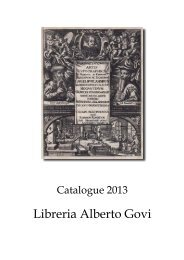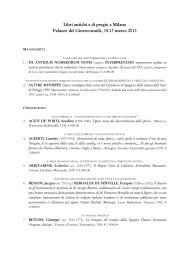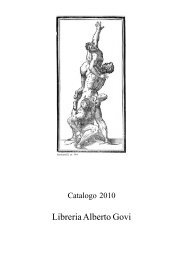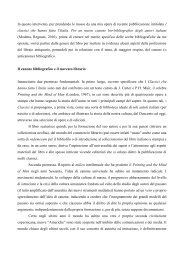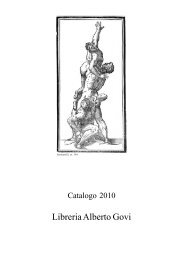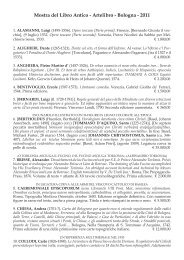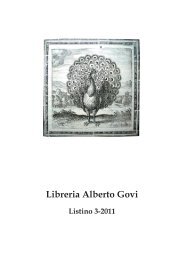List 4-2013 - Libreria Antiquaria Alberto Govi
List 4-2013 - Libreria Antiquaria Alberto Govi
List 4-2013 - Libreria Antiquaria Alberto Govi
You also want an ePaper? Increase the reach of your titles
YUMPU automatically turns print PDFs into web optimized ePapers that Google loves.
dispositio sconnessa si applica perfettamente ai Marmi, i quali<br />
da questo punto di vista sono una selva, cioè una raccolta di<br />
materiali privi di nessi fra loro. E sono materiali esteticamente<br />
fruibili perché sono per lo meno curiosi: curiose sono le storie<br />
e le favole, curiosi sono i soggetti del cibo, della chiromanzia,<br />
dei sogni, curiosi la vita di Arnaut Daniel e vari altri materiali<br />
ai quali se ne mescolano altri che potrebbero sembrare<br />
uggiosi, come i precetti ‘utili all’huomo’ o alcune discussioni<br />
sull’onore. Ma per poter parlare di una ‘selva’ affine a quella di<br />
[Pedro] Mexía bisogna postulare che i Marmi, come la Silva<br />
[de varia lección (1540)], siano ricavati tutti o almeno in gran<br />
parte da libri altrui, che siano frutto di una vera ‘lectio’ o scelta<br />
attuata su opere varie. Questo… è un punto cruciale, e fino a<br />
quando non si farà un lavoro sistematico sulle fonti sarà imprudente<br />
affermare senza ombra di dubbio che i Marmi siano<br />
una ‘selva’ nel senso indicato… Ai materiali di base Doni sovrappose<br />
ciò che è tipico del suo umore – bizzarria, riboboli,<br />
sbandate fuori tema, note dissacranti e antifrastiche, curiosità,<br />
capricci e costanti scadute tonali – e lo espresse attraverso le molte voci dei personaggi che frequentano i dialoghi dei Marmi. La combinazione<br />
creò quella dissonanza… che mortifica l’erudizione, che invalida il sapere, che abbraccia un Seneca ma lo respinge poi come soporifero, che<br />
propone norme dietetiche a crapuloni e beoni, che sciorina informazioni cabalistiche ad allocchi. Era questo il modo con cui Doni viveva un<br />
atteggiamento culturale dei suoi tempi o almeno di quel gruppo d’avanguardia che fra gli anni ’40 e ’60 voltò le spalle all’Umanesimo e prese a<br />
parodiarne l’erudizione…” (P. Cherchi, La “selva” dei ‘Marmi’ doniani, in: “Esperienze Letterarie”, XXVI, 2001, pp. 3-6, 9 e 35-36).<br />
“Anton Francesco Doni went beyond Franco, Domenichi, Lando, and Landi in his rejection of Cinquecento learning. The others believed<br />
that learning had declined and attacked individual humanists, but Doni argued that the studi liberali were fundamentally inadequate to teach<br />
men virtue… His I Marmi (1552-1553), or conversations overheard in the evening on the marble steps of the Florentine cathedral, contains a<br />
dialogue in which he rejects the studi liberali. A poultry vendor, a broker, and an unidentified third person begin to discuss how to avoid vice<br />
and to foster virtue, defined the traditional terms as the love of patria, wife, and children. But the studi liberali can not teach virtue… Grammar<br />
can teach style and poetry is important; history is ‘noble’, but knowledge of the lives and activities of the ancients has only a negative value, a<br />
warning to men to avoid their faults. With arithmetic and geometry one can count one’s possessions, but it is of no avail if one does not divide<br />
them for charity. Neither is virtue the result of the study of Stoic or Aristotelian philosophy. Books can not teach men virtue because men<br />
- 16 -



